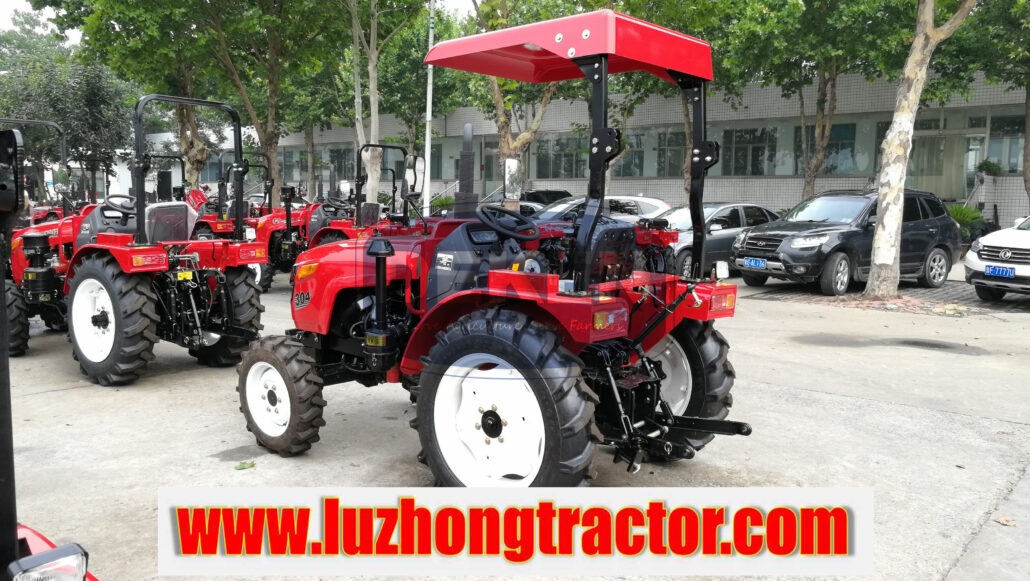Four wheel tractor tire damage protection
Author:Ricdro
Compared with large and medium-sized rubber tractors, small four-wheel tractors have a much shorter tire life. However, the current tires are basically the same except for special applications, regardless of their size. The tire life of a small four-wheel tractor is so short? This is mainly determined by its characteristics. Understanding the characteristics of the small four-wheel and taking appropriate preventive measures is very necessary for the agricultural machine operators.
First, the main features
1. Structural features. The driving wheels of most small four-wheel tractors are fixed on the semi-axle in the form of a flange. This structure greatly limits the adjustment of the wheel pitch of the driving wheel, so the adjustment of the characteristics of the road surface is poor, especially When the large and medium-sized tractors drive over the deeper ruts or work in the direction of the furrows on the ridges, they are often in a “squeezed tire” state, which increases the wear of the tires.
2. Features of use. Due to its small size, light weight, easy operation, wide range of use, and high maneuverability, the small four-wheel tractor is more likely to damage the tire than the large and medium tractors in the following aspects. 1 There are many work items and the working environment is poor, so there are many opportunities for friction, crushing, impact and erosion. 2 The load capacity is low, and it is often operated under overload. 3 small, easy to operate, so that people who do not understand the maintenance technology can also operate, the operator can not find the signs of tire damage, it is difficult to ensure that the tires work in good condition.
3. Management characteristics. The small four-wheel tractors are basically all owned by individuals. There is no top-down management system. The operators only use them and do not pay attention to maintenance.

Second, preventive measures
1. Regularly check the technical status of the parts associated with the tire, such as the technical status of the rim, the bead, the wheel (generally referred to as the front wheel body, etc.). Also check the technical status of parts that have a large impact on the tire, such as the semi-axle, front axle, frame, and the bearing state of the traveling mechanism. If problems are found, they should be adjusted and repaired in time.
2. Avoid contact with kerosene, diesel, strong acid, strong alkali, high temperature objects.
3. Avoid tire pressure on objects that are prone to equipment damage, such as iron filings, thorns, broken glass.
4. Try to drive on a road suitable for small four-wheel tractors.
5. If you do a certain job for a long time, adjust the tire installation status and tire type as needed.
6. Reasonable use of counterweights. When loading in the field, the weight should be increased; when transporting by road, the weight should be reduced. Also, do not sit on the drive wheel fender or take other heavy objects.
7. Master the pressure inside the tire. For small four-wheel tires, don’t run out of gas (the field work can be slightly lower, and the road transport should be more adequate). When fixing work for a long time, it is better to pad the frame so that the tire is not affected by the gravity of the locomotive. At this time, the air pressure in the tire can be retained to the normal working pressure, and the tire grounding position is periodically replaced (ie, rotated). When parking for a long time, the rack should be put up, so that the tire is completely off the ground, the tire gas is released or less than 1/5 of the normal working pressure is retained. The tire assembly can also be removed, vented and stored, taking care to avoid crowding and Sun and rain.
8. When driving in a hilly area or a mountainous area, the pressure on the ground is reduced due to the up and down slope, which tends to cause relative sliding of the tire to the ground, which aggravates the wear of the tire. In this case, the snow chain can be added. When the snow chain cannot be added, the weight of the driving wheel can be appropriately increased, and the traction load can be appropriately reduced.
9. Once the tire is found to have more serious equipment damage, it should be repaired in time. When the tire tread wear is serious, it should be sent to the repair department for renovation.
10. If the tires are regularly eccentric due to long-term operation, the left and right tire positions should be changed to make the tires wear evenly.
